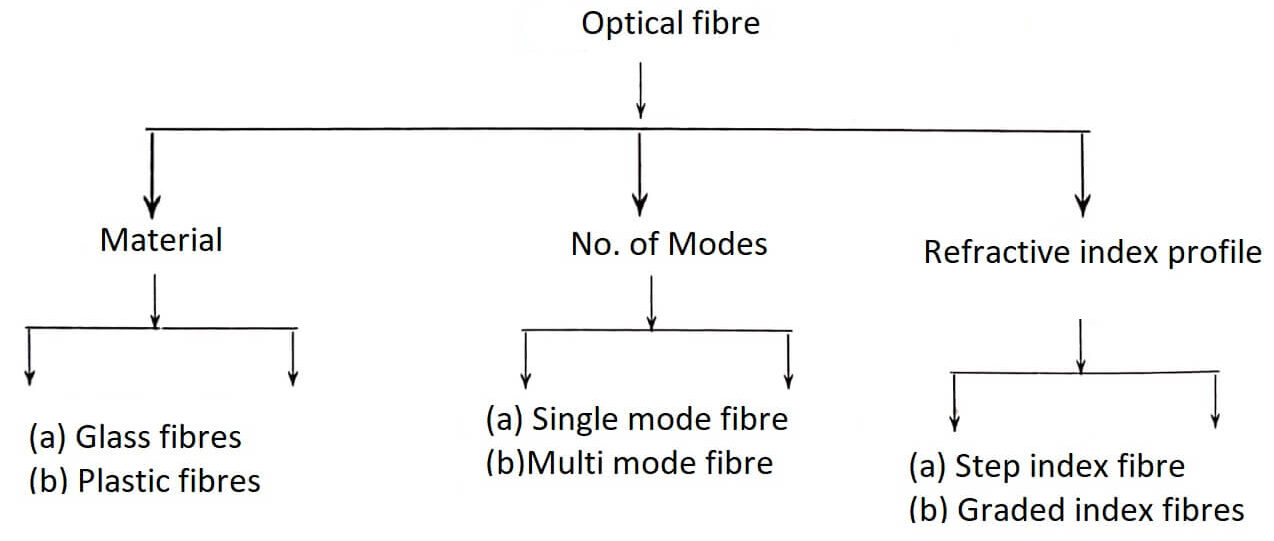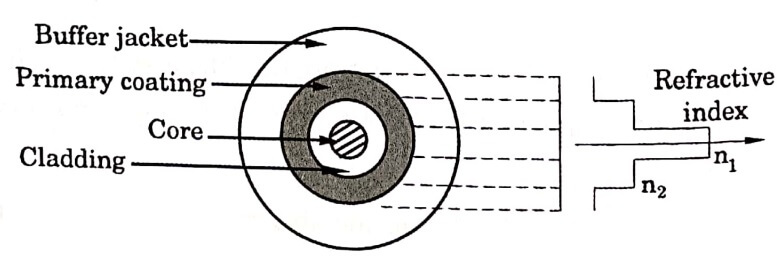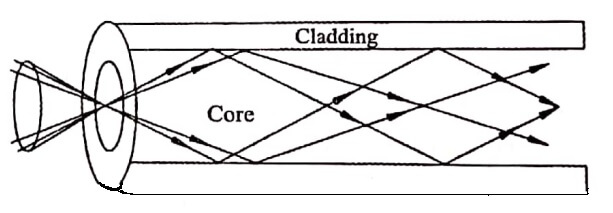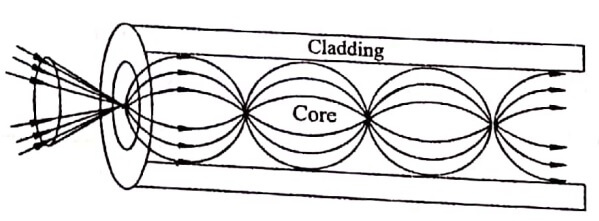Optical fibres are classified based on
(i) Material, (ii) Number of modes, (iii) Refractive index profile

Classification based on material
It can be classified into two types. a. Glass fibre b. Plastic fibre
a) Glass fibre
If the optical fibres are made by the fusing mixtures of metal oxides and silica glass, then it is known as glass fibre.
Examples
The glass fibres can be made by any one of the following combinations of core and cladding.
GeO2 −SiO2 core ;SiO2 cladding
P2O5 −SiO2 core ;SiO2 cladding
b) Plastic fibres
If the optical fibres are typically made of plastics, then it is known as plastic fibre.
Examples
The plastic fibres can be made by any one of the following combinations of core and cladding.
Polystyrene core – Methylmethacrylate cladding.
Polymethylmethacrylate core – Co-polymer cladding.
The advantage of plastic fibres are more flexible, easy to install, less weight and less expensive than glass fibre. It is tough and durable than glass fibre.
The disadvantage is it exhibits considerably greater signal attenuation (energy loss) than glass fibres.
Classification based on number of modes
Depending on the number of modes of propagation the optical fibres are classified as
a. Single mode fibre b. Multi mode fibre
a. Single mode fibre
If there is only one path for the light to propagate down the cable, it is called a single mode fibre.
- Single mode fibre has a very small core diameter so that it can allow only one mode of propagation.
- Ordinary light cannot be propagated through this single mode fibre.
- The optical loss is very less.
- The cladding diameter must be large compared to the core diameter.
- Generally single mode fibres are called step index fibres.
- It can be excited or used only by using semiconductor laser diaode.
- Example : cable TV transmission, telephone transmission.

Structure
Band width : More than 50MHz.
Advantages
-
It facilitates to transmit signal to longer distance.
-
It is free from intermodal dispersion.
-
It has higher bandwidth, thus used in long haul communication.
Disadvantages
-
It is difficult to launch the light through the fiber.
-
It is difficult to achieve end to end connection of similar fibers.
Application
Because of it its high band width, they are used in long haul communication systems.
b. Multi mode fibre
If there is multi path for the light to propagate down the cable, it is called a multimode fibre.
- Multimode fibre has a large core diameter so that it can allow many modes of propagation.
- Ordinary light can propagate through this multimode fibre.
- The optical loss is more.
- The cladding diameter is less compare to core.
- It can be excited or used by LED.
- Example: LAN (Local Area Network)

Structure
- Core diameter : 5−10 μm.
- Cladding diameter : Generally around 125 μm.
- Buffer jacket diameter : 250−1000 μm.
- Numerical aperture : 0.08 to 0.15
- Band width : More than 50MHz.
Advantages
-
It is easy to launch the light through the fiber.
-
It is easy to achieve end to end connection of similar fibers.
Disadvantages
-
It used to transmit signal to shot distance.
-
It suffer intermodal dispersion.
Application
Because of its less bandwidth it is very useful in short haul communication systems.
(1) Difference between Single mode fibre and Multi mode fibre
| S. No | Single mode fibre | Multi mode fibre |
| 1. | Light can propagate through the fibre in only one mode. | Light can propagate through the fibre with multiple number of modes. |
| 2. | The fibre core diameter is very small. | The fibre core diameter is very large. |
| 3. | The difference between refractive indices of the core and cladding is very small. | The difference refractive indices of the core and cladding is large. |
| 4. | It carry information to longer distance. | It carry information to shorter distance. |
| 5. | Launching of light into the fibre and coupling process is not easy. | Launching of light into the fibre and coupling process is easy. |
| 6. | Used in long haul communication. | Used in LAN( Local Area Network). |
| 7. | The production cost is high. | The production cost is low. |
| 8. | Since light propagates in single mode, no dispersion occurs i.e., no degradation of light signal takes place. | Due to multimode propagation and material scattering, there is signal degradation. |
| 9. | It is very difficult to connect two fibre( end to end connection ). | End to end connections are very easy. |
Classification based on the refractive index profile
The optical fibres are classified into two types,
a. Step index fibre b. Graded index fibre
a) Step index fibre :
In this fibre, the variation in refractive indices of air, cladding and core varies by step by step. Thus, it is known as step index fibre.
- A step index fibre has central core with uniform refractive index.
- The cladding has less refractive index than core.
- It is used in under sea-level transmission.
- It involves both single mode and multimode fibres.

b) Graded index fibre :
In this fibre, the refractive index of the core is non-uniform. It is maximum at the centre and decreases gradually with distance towards the surface. Thus, it is known as graded index fibre.
- It is a multimode fibre with a large core diameter.
- The cladding has a lesser refractive index than that of core.
- At interface, the refractive index of core and cladding is equal.
- The graded index fibre will be of multimode system.

Fig 1.4 Multi step index
Based on refractive index and mode of propagation, optical fibres are further classified into three types. They are given below:
(c) Graded index multi mode fibre
(a) Step index single mode fibre
- Single mode fibers are those that accept only one light ray that first reaches the core.
- This enables the light pulse to make a cleaner signal at the receiving end.
- The bandwidth of light it carriers is also higher.
- The main drawback of a single mode fibre is the smaller fibre core diameter. It makes harder to couple light into the fiber.
- Hence, the manufacturing of most single mode fibre optic components, such as isolator, attenuator, etc., is expensive.

Fig 1.5 Step index single mode fibre
(b) Step index multi mode fibre
-
It is the simplest type of optical fibre whose core diameter ranges from 100 to 970μm.
-
Light signals can enter the core at different angles, hence following different paths (modes) within the core.
-
The time interval between each output signal will, therefore, be different.
-
Here a pulse of light that entered as a narrow beam gets dispersed. This spreading of the optical pulse is called modal dispersion.
-
Information loss can occur when one pulse overlaps with an adjacent pulse.
-
This type of fibres is basically used in data links that do not require very large bandwidths (frequency).

Fig 1.6 Step index multi mode fibre
(c) Graded index multi mode fibre
- Modal dispersion is reduced in a multi mode graded index fibre.
- The refractive index for each layer decreases away from the central axis. Hence, light travelling near outside of the core has a faster average velocity; light travelling near the center of the core has the slowest average velocity.
- As a result, all the rays arrive at the other end almost at the same time.

 Fig 1.7 Graded index multi mode fibre
Fig 1.7 Graded index multi mode fibre| S. No | Single mode fibre | Multi mode fibre |
| 1. | The refractive index of core, cladding and air varies in a step by step manner. Hence, called step index fibre. | The refractive index of core, cladding and air varies with radial distance. Hence, called graded index fibre. |
| 2. | It is used to transmit single multimode signals. | It is mainly used to transmit multimode signals. |
| 3. | The light rays are propagate through the fibre in zig – zag manner. | The light rays are propagate through the fibre in helical or spherical manner. |
| 4. | Single mode step index fibres are expensive and difficult to manufacture | Graded index fibres are easy to manufacture. |
| 5. | The bandwidth for multimode step index fibres is lower. | The bandwidth for multimode graded index fibres is higher. |
| 6. | Numerical aperture is very less for single mode step index fibre but is more multimode step index fibre. | Numerical aperture is high. |
| 7. | It is used for long transmission applications. | It is used for short transmission applications. |
| Read More Topics |
| Fibre optical sensors |
| Fibre optical communication system |
| Introduction and construction of fibre optics |





